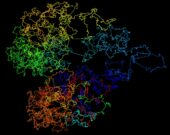Unraveling links to possible origins, better treatment for genetic disorders
New tool designed at MU will allow scientists to study a detailed view of the interaction between genes, which can lead to diseases, disorders and cancer
July 29th, 2019
COLUMBIA, Mo. – In recent decades, scientists have successfully mapped the human genome, but it’s viewed in a way similar to viewing a screen without a sharp resolution picture. Now a new digital tool designed at the University of Missouri will allow scientists to study the detailed interactions between chromosomes within the human genome through a high-resolution, three-dimensional digital model. This model will help increase scientific knowledge while advancing precision medicine.
“DNA is the code of life for all living systems, including people,” said Jianlin “Jack” Cheng, the William and Nancy Thompson Professor in electrical engineering and computer science in the MU College of Engineering. “Our tool can help scientists view specific genes and study their interactions, which could help identify factors leading to — and treatment for — various cancers, diseases or disorders.”
Using data gathered from existing one-dimension sequences of the human genome, Cheng and his team created an algorithm, or set of instructions, to develop their high-definition 3D model. Among the potential applications, Cheng hopes his model can help scientists better see the differences between healthy cells and cancer cells, identify what could cause the cancer to occur and see if there is a way to reverse engineer it.
“Gene interactions are essential for our bodies to function,” Cheng said. “By visualizing the genes in 3D, and at high-definition, scientists can better visualize these interactions and study long-range interactions that we couldn’t see before. For example, right now scientists might not see the interaction between gene A and gene Y, but with this new tool we can see these two genes are very close to each other because of a process called folding. When the folding malfunctions, it can cause adverse issues, such as diabetes or Alzheimer’s disease.”
This research highlights the power of translational precision medicine, an initiative underway at MU. MU’s initiative will bring together industry partners, multiple schools and colleges on campus, and the federal and state government to enable precision and personalized medicine. Scientific advancements made at MU will be translated into new drugs, devices and treatments that deliver customized patient care based on an individual’s genes, environment and lifestyle, ultimately improving health and well-being of people.
The study, “Hierarchical Reconstruction of High-Resolution 3D Models of Large Chromosomes,” was published in Scientific Reports. Other authors on the study were Tuan Trieu and Oluwatosin Oluwadare in the MU College of Engineering. Funding was provided by a grant from the National Science Foundation (DBI1149224). The content is solely the responsibility of the authors and does not necessarily represent the official views of the funding agencies.



 Photos (2):
Photos (2):